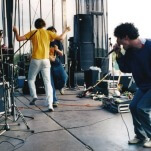Catching Up With The True Lives of the Fabulous Killjoys Writer Gerard Way
As the former lead singer of glam punk heroes My Chemical Romance, Gerard Way knows how to tell a story. Concept albums Three Cheers for Sweet Revenge and The Black Parade unspooled bittersweet, goth-tinged tales of resurrected gunslingers and postmortem cavalcades into the band’s theatric thrash with style and substance. Way made the full transition to scripting with his 2007 Dark Horse comic The Umbrella Academy, the portrait of a dysfunctional family of superhero misfits searching for purpose while saving the world from mind-bending threats. A graduate of the School of Visual Arts in Manhattan and a former intern at DC’s Vertigo imprint, Way proved just as adept with a pen as a microphone, winning an Eisner Award in 2008 for Best Limited Series.
Today marks the debut of Way’s new series The True Lives of the Fabulous Killjoys, a heady descent into post-apocalyptic intrigue and grind house psychedelia that completes the story started in the 2010 MCR album Danger Days and its videos for singles “Na Na Na” and “Sing.” Along with co-writer Shaun Simon and artist Becky Cloonan, Way paints a conflicted world where a gang of teenage vagrants fights a totalitarian corporation and its legion of vampire-masked drones while a pair of android prostitutes shares a secret bond.
Over two interview phone sessions, Way chatted with Paste about his new comic’s connections to his past as a commercial recording artist and what inspired his aesthetic shift from white face paint to red hair dye. Way also digs deep into the underlying sociological issues at Killjoys’ heart and how Dora the Explorer, the Blade Runner documentary, and the Sega Master System influenced it.
Paste: Congratulations on your first issue of The Fabulous Lives of the Killjoys. This is a continuation of the story you started in your Danger Days album from My Chemical Romance. Did this plot emerge after you finished the album or was it a part of the story the whole time?
Gerard Way: The deal is that I had written three videos (“Na Na Na,” “Sing,” and “The Only Hope For Me Is You”), and the third video had never gotten made. By the time we had completed the second video, we just ran out of budget money. At the time, somebody was managing us and not keeping an eye on this stuff. Long story short, there was no budget. So I wrote a video, and of course it ends up being the most expensive one, as the last part would usually be. But we couldn’t make it!
Killjoys started its life as a very different comic. It was heavily-rooted in nineties Vertigo post-modernism. There’s a lot of very cool, abstract ideas in it; I wouldn’t even call it a superhero book. That (comic) was a visual and thematic inspiration on what would become the album Danger Days. It was pretty loose, though. This was going to be my interpretation of the story, so there’s way more science fiction involved. And what I need to say to the world needed to be a little more direct, so I boiled it down to something that’s still very smart and challenging, but I thought was definitely easier to understand through song or visual.
Then (Killjoys artist) Becky Cloonan drew a 7-inch for “The Only Hope For Me Is You,” which was going to be the last video single. I realized I was out of budget, so I said ‘just make this the girl from the first and second video at 15. And have her shave her head or chop her hair off like in The Legend of Billie Jean, because that’s how the video was supposed to start.’ So (Cloonan) sends this drawing over and I’m on tour with Blink 182 in a hotel on an off day. I get this drawing and I’m so immediately blown away by it. I call Shaun, my co-writer and co-creator, and I say ‘open your email, I’m going to send you something.’ I ask him ‘how does this image make you feel?’ We talked for two hours. By the end of the conversation we both realized that that image was the comic, and the third video was basically the comic. So we figured how we were going to make this interesting and exciting for six issues and complete the story. And that was the final direction. It was pretty obvious to us.
-

-

-

-

-

- Curated Home Page Articles By Test Admin October 21, 2025 | 3:10pm
-

- Curated Home Page Articles By Test Admin October 21, 2025 | 2:57pm
- Urls By Test Admin October 21, 2025 | 2:57pm
- Curated Home Page Articles By Test Admin October 21, 2025 | 2:55pm
-

-

-

-

-

-

-

-

-

-

-

-

-

-

-

-

-

-

-

-

-

-

-

-

-

-

-

-

-

-





































